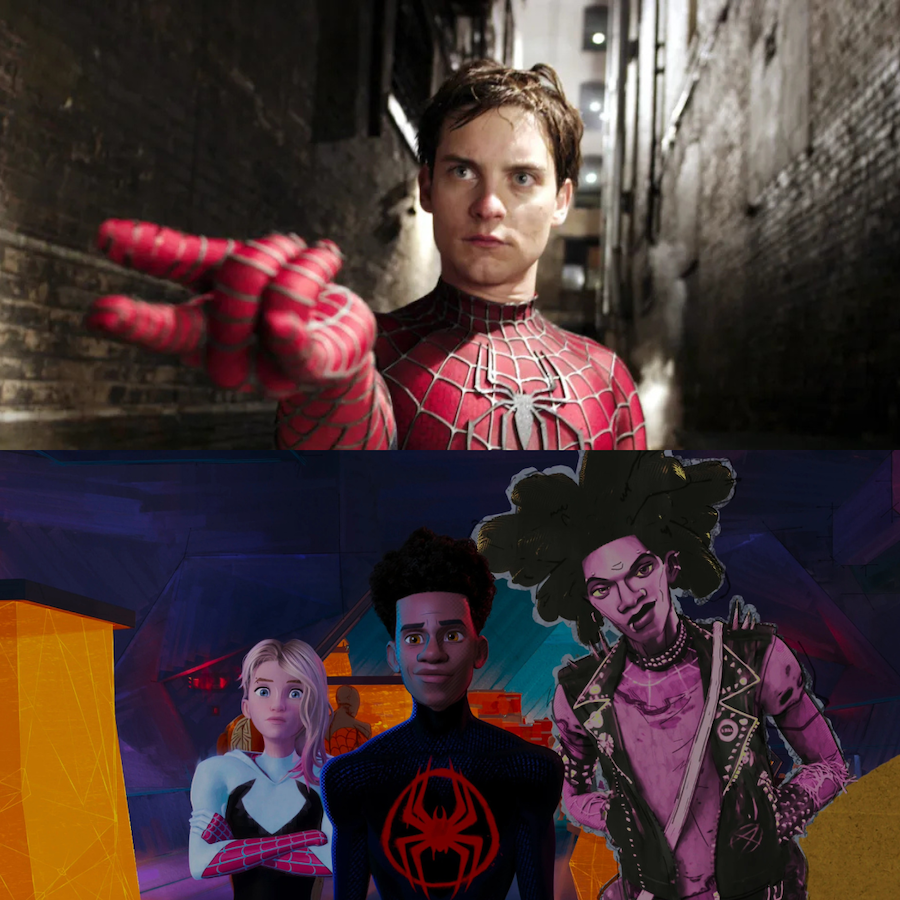Since his first appearance in the comic Amazing Fantasy #15 (1962), Spider-Man has become an American pop culture icon, symbolizing how the ordinary can become extraordinary. The character personifies post-war ideals of personal responsibility into the academically gifted, scrawny white boy we all know and love: Peter Parker. He not only reflects the ideals of mid-twentieth century America, but defines what a hero can be. In contrast, the mainstream emergence of Miles Morales in Spider-Man Into the Spider-Verse (Peter Ramsey, Rodney Rothman, Bob Persichetti, 2018), reimagines Spider-Man as a Black-Puerto Rican teenager from Brooklyn, signifying a broad cultural shift in how heroism and belonging are represented. The movement of Spider-Man from Peter Parker’s homogenous world to Miles Morales’s intersectional one illustrated how marginalized identities have transitioned from the periphery to the centre of media narratives, redefining who gets to be the hero in contemporary culture.
The most popular renditions of this character in the 21st century are Sam Raimi’s Spider-Man trilogy starring Tobey Maguire (2002–2007), followed by Andrew Garfield in The Amazing Spider-Man (Marc Webb, 2012) and The Amazing Spider-Man 2 (Marc Webb, 2014). When asked about bringing other iterations of Spider-Man to life, producer of the latter, Avi Arad, has stated that “Peter Parker was the one and only Spider-Man that he would ever put onscreen,”(1) going on to say that multiple Spider-Men would end the franchise entirely.(2) Our grasp on the character was tightened by the next three movies created by Marvel and Sony, starring Tom Holland as Peter Parker, first introduced in Spider-Man: Homecoming (Jon Watts, 2017). Whilst the comics include many iterations of Spider-Man like Ben Reilly (the Scarlet Spider), Miguel O’Hara (Spider-Man 2099), and Miles Morales (in-text), we’ve barely begun to see such excursions fully embraced on the big screen – leaving us with our three, very friendly, very white Spider-Men.
Countering this traditionally hegemonic symbolism, Spider-Man: Into the Spider-Verse (Peter Ramsey, Rodney Rothman, Bob Persichetti, 2018) introduces Miles Morales, a black teenager in Brooklyn with loving, and living, parents. Reimagining the Spider-Man archetype as Miles created a film with rich cultural references and a diverse supporting cast. Culture pulses through the film’s electric hip-hop score, graffiti-inspired visuals, and the rhythm of its language and characters. Many black creatives, including Duckwrth, Swae Lee, and Vince Staples contributed to its distinctive sound and energy. The result is a Spider-Man who embodies intersecting identities without being reduced to just one. Miles Morales is both the focus and the heart of the story. He is Spider-Man in this movie, not simply another variant. The movie platforms his personal flair, bringing elements of Black and Hispanic culture to light and shifting the way racialized youth are typically represented in media. This role alone has given young audiences a new kind of role model, one defined by empathy and creativity rather than toughness or defiance.
As a society, we’ve long understood Spider-Man as a symbol of good, “Spider-Man isn’t a person. Spider-Man is an ideal – a set of values, principles, and struggles that express themselves in varying ways for different people at different times.”(3) However, the heroes’ representation has historically been narrow. Miles Morales expands what audiences imagine a hero can be. His story allows multicultural narratives to move into the mainstream rather than being relegated to side characters or niche audiences. During its theatrical release in 2018, Into the Spider-Verse earned over $394 million worldwide,(4) proving there is a strong appetite for diverse storytelling. Released the same year, Black Panther (Ryan Coogler, 2018) was another major milestone for Black representation in superhero narratives. Previous Black heroes have been far and few, characters like Nick Fury and Luke Cage are often limited to the familiar trope of the troubled, morally grey figure who appears only in service of white protagonists. For Black youth, Miles Morales represents something revolutionary; a positive identification and genuine sense of belonging. His story offers racialized youth someone to relate to, not through struggle alone, but through creativity, community, and heroism. The success of Into the Spider-Verse and Black Panther created a surge of confidence in the industry’s willingness to normalize racial diversity within beloved American characters. Miles also brings a fresh perspective to teenage culture, replacing Peter Parker’s 1960s ideal of American youth with something more modern, layered, and authentic. Yet, this progress prompts a critical question: while representation is becoming more visible, is Hollywood simply packaging diversity for profit, and what does that mean for authentic inclusion?
Miles Morale’s success redefines what it means to be a hero in contemporary culture, expanding the boundaries of who can wear the mask and what stories are worth telling. His presence challenges perpetual norms in popular media, illustrating that diversity doesn’t have to be a deviation from tradition but a continuation and a life boat. Into the Spider-Verse proves that inclusivity can coexist with mainstream success, yet it also reminds us to question the motives behind representation. True progress lies not in the commercialization of diversity, but in the authentic celebration of it. Every young viewer should be able to see themselves not just reflected, but empowered and heard. In achieving this balance, Miles Morales stands as a rare example of genuine, accurate representation done right – both culturally and creatively.


Lakshyadeep singh sandhu
I think this student did a great job comparing the two versions of Spider-Man — Peter Parker and Miles Morales. Their analysis really shows how the character has changed over time from representing the traditional, white, middle-class American hero to someone who reflects a much more diverse and modern world. They clearly explain how Peter Parker originally symbolized responsibility and the “ordinary guy turned hero” ideal from the 1960s, while Miles Morales represents a shift toward inclusion and cultural authenticity.
The main points are well organized. The student talks about how Into the Spider-Verse celebrates Black and Hispanic culture through its visuals, music, and energy, and how Miles’s story allows more young people to see themselves as heroes. I especially liked that they questioned whether Hollywood’s push for diversity is genuine or just a marketing move — that added real critical depth.
She used a few sources effectively, especially quotes from producers and commentary about cultural change. Still, She could’ve made it even stronger by connecting their points to media theories — for example, how audiences interpret identity or how representation affects belonging.
The images fit perfectly with their discussion. Tobey Maguire’s Spider-Man shows the older, traditional version, while Miles and the Spider-Verse crew visually show what inclusivity looks like in today’s media. Overall, their analysis felt thoughtful, well-researched, and connected cultural meaning with real examples from pop culture in a way that was easy to follow.